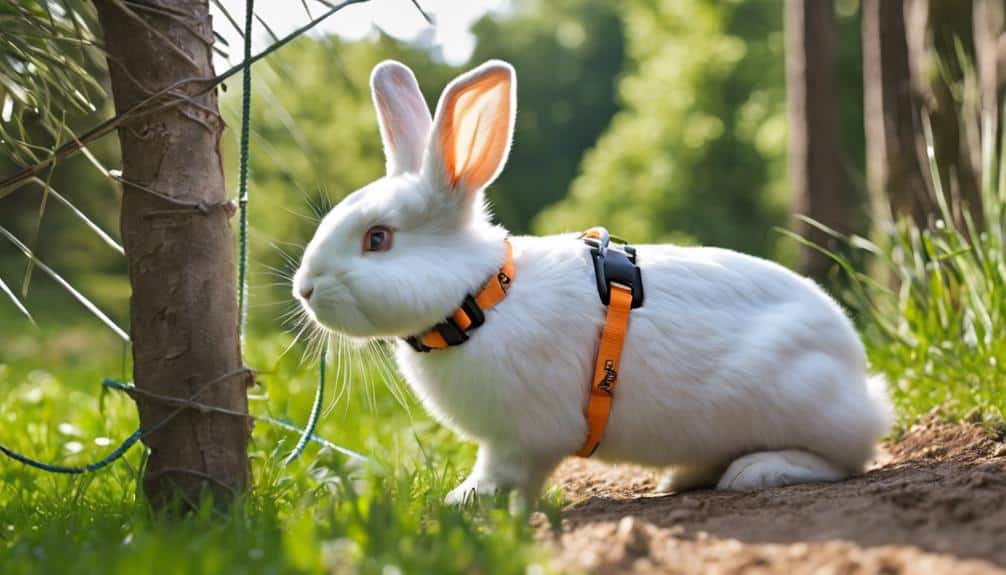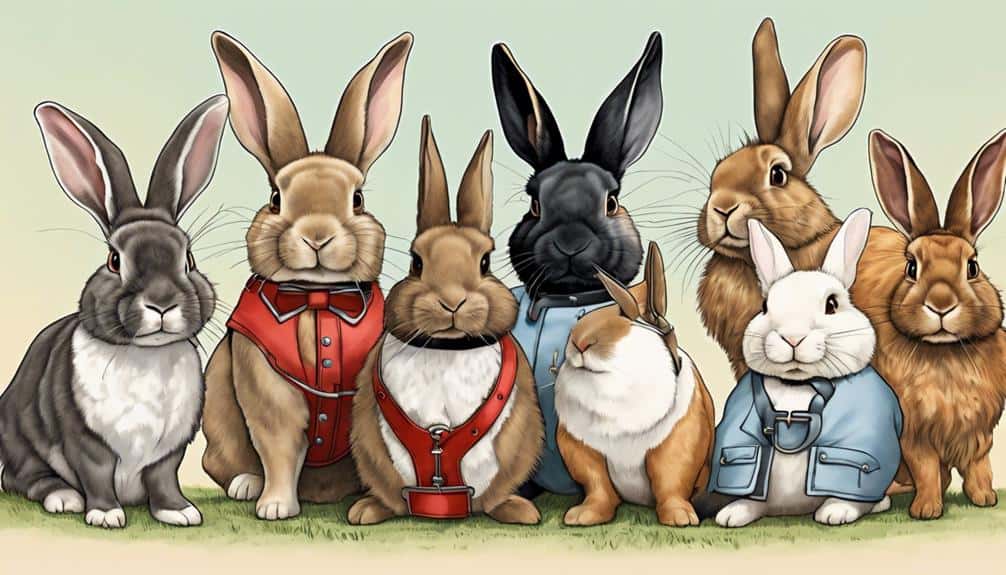Do you ever wonder if your fluffy companion can rock a harness like a seasoned explorer? The answer might surprise you.
Bunnies can wear harnesses. It is important to use a harness specifically designed for small animals like rabbits and to make sure it fits properly and is comfortable for the bunny. Training and getting the bunny used to wearing a harness is also important.
Discovering the possibilities and benefits of harness training for bunnies could open up a whole new world of adventure and bonding experiences for you and your furry friend.
But before you take that leap, there are important considerations and steps to make sure a safe and enjoyable journey.
Contents
- 1 Key Takeaways
- 2 Benefits of Harness Training for Bunnies
- 3 Choosing the Right Rabbit Harness
- 4 Harness Training Steps for Bunnies
- 5 Tips for Safely Introducing a Harness
- 6 Leash Training Different Rabbit Breeds
- 7 Taking Your Bunny on Outdoor Adventures
- 8 Frequently Asked Questions
- 9 Can Harnesses for Bunnies Be Used as an Alternative to Clothes?
- 10 Conclusion
Key Takeaways
- Harness training benefits bunnies by promoting safe outdoor exploration and mental stimulation.
- Choosing the right rabbit harness ensures comfort, safety, and adjustability for growth.
- Harness training steps involve gradual introduction, positive reinforcement, and monitoring behavior for adjustments.
- Leash training different rabbit breeds requires considering temperament, adaptability, and breed-specific characteristics.
Benefits of Harness Training for Bunnies

Harness training for bunnies offers a myriad of benefits, including promoting safe exploration outdoors, providing mental stimulation, and strengthening the bond between owners and their furry companions. By utilizing a harness and leash, rabbits can safely venture outside under supervision, preventing them from darting away unexpectedly. This controlled outdoor exposure not only satisfies their natural curiosity but also allows them to exercise and socialize in a secure environment.
Wearing a harness enables rabbits to experience new sights, smells, and textures, enriching their mental well-being. The stimulation from exploring the outdoors can prevent boredom and promote a healthier, happier bunny. Additionally, the bond between owners and their rabbits deepens through the shared experience of harness training. The trust developed during this activity fosters a stronger connection, leading to a more fulfilling relationship between the owner and their beloved pet. Overall, harness training is a valuable tool for ensuring the well-being and happiness of both rabbits and their owners.
Choosing the Right Rabbit Harness
When selecting a rabbit harness, prioritize comfort and safety by opting for a soft design with guarantee-release buckles and an H-shaped structure. A soft harness made of materials like neoprene provides a gentle touch against your bunny’s skin while ensuring a secure hold. Look for harnesses with guarantee-release buckles for easy removal and adjustment. The H-shaped design helps distribute pressure evenly, preventing strain on your bunny’s delicate body.
Choose a harness with a back ring for leash attachment. This placement avoids neck strain for your bunny, promoting a more comfortable walking experience. Adjustable harnesses are essential to accommodate your rabbit’s growth and ensure a snug fit without restricting movement. If you have a small rabbit, consider harnesses specifically designed for their size to guarantee a proper fit and enhance safety during walks.
Harness Training Steps for Bunnies

Introducing your bunny to harness training involves gradual and positive exposure to guarantee comfort and safety during outdoor adventures. Start by calmly introducing the harness to your bunny, using a soothing voice and gentle movements. Make the experience positive by offering treats and rewards to create a pleasant association with the harness. It’s essential to make sure that the harness fits snugly but not too tight, as you want to avoid any discomfort or potential injury to your furry friend.
During harness training, practice short indoor sessions for your bunny to get accustomed to wearing the harness before venturing outdoors. Watch your bunny’s behavior and body language closely during these training sessions to make sure they’re comfortable and safe. By monitoring their reactions, you can adjust the fit or approach as needed to make the training process smooth and stress-free for your bunny.
Tips for Safely Introducing a Harness
To safely introduce a harness to your bunny, begin by creating a calm and quiet environment for the initial exposure. It’s important to keep the setting peaceful to prevent your bunny from feeling scared or stressed. When wearing a harness, use positive reinforcement techniques like offering treats and gentle handling to help your bunny associate the harness with positive experiences. This approach can make the process more enjoyable for your furry friend and facilitate their acceptance of the harness.
Make sure the harness fits snugly but not too tight, allowing your bunny to move comfortably. Monitor your bunny’s behavior closely for any signs of discomfort or distress while wearing the harness. If you notice any negative reactions, consider adjusting the fit or taking a step back in the training process. Remember, patience and consistency are key in behavioral training. Practice regularly to help your bunny adjust and feel secure while wearing the harness.
Leash Training Different Rabbit Breeds

If you have a bunny of a specific breed, understanding their temperament and characteristics can greatly impact the success of leash training. Leash training different rabbit breeds requires tailored approaches to accommodate their unique personalities. Here are three key points to contemplate:
- Temperament Variation: Different rabbit breeds exhibit diverse temperaments, affecting their response to leash training. Some breeds, like the Mini Lop or Holland Lop, known for being sociable and outgoing, may take to leash training more readily.
- Adaptability: Certain rabbit breeds, such as the Mini Lop or Holland Lop, are known for their adaptability and may quickly adjust to the harness and leash. Their easygoing nature can make the training process smoother compared to breeds that are more reserved or skittish.
- Patience and Gentle Training: Breeds like the Netherland Dwarf or Lionhead may require more patience and gentle training during leash introduction. Understanding the specific characteristics of these breeds can help you approach leash training in a way that suits their needs best.
Taking Your Bunny on Outdoor Adventures
When taking your bunny on outdoor adventures, it’s important to understand the basics of harness training. Ensuring your bunny’s safety requires following outdoor safety tips and using the right gear and accessories.
Harness Training Basics
Introducing your bunny to harness training is an important step towards safely enjoying outdoor adventures together. To ascertain successful harness training, follow these key steps:
- Gradual Introduction: Start by placing the harness near your bunny for them to sniff and investigate. Slowly progress to draping it over their back without fastening it, allowing them to get used to the feeling.
- Positive Reinforcement: Use treats and praise to reward your bunny when they show positive behavior towards the harness. This encourages them to associate the harness with pleasant experiences.
- Patience and Consistency: Harness training takes time and patience. Practice short sessions daily, gradually increasing the time your bunny wears the harness to build their comfort level.
Outdoor Safety Tips
To guarantee the safety and well-being of your bunny during outdoor adventures, it’s important to choose quiet, predator-free areas for walks and avoid locations with potential risks such as wild rabbits or treated grass.
Keeping your bunny on a leash guarantees they stay close and safe. Be attentive to anxiety triggers and the delicate bones of rabbits when taking them outside. Always keep an eye on your bunny to prevent any accidents or unwanted encounters.
Prioritize their enjoyment and health by selecting suitable locations for outdoor walks. By being cautious and proactive, you can create a safe and pleasant experience for both you and your furry companion.
Gear and Accessories
Harnesses designed specifically for bunnies are an essential piece of gear to guarantee the safety and comfort of your furry companion during outdoor adventures. When choosing the best harness for your rabbit, make sure to take into account these important points:
- Proper Fit: Ensuring the harness fits snugly but comfortably is important to prevent discomfort or injury.
- Features: Look for harnesses with quick-release buckles and soft, adjustable designs to enhance your rabbit’s comfort and safety during walks.
- Leash Attachment: Attach the leash to a back ring, not the neck, to securely control your bunny during outdoor excursions.
Frequently Asked Questions
Can I Walk My Bunny on a Harness?
You can walk your bunny on a harness to enjoy outdoor adventures and backyard playtime. Incorporate indoor exploration with bunny toys and bonding activities for bunny enrichment. Use a soft, adjustable harness for comfort and security.
Is It Safe for Rabbits to Wear Collars?
Wearing collars isn’t safe for rabbits due to neck injuries and choking risks. Harnesses are a better choice, offering security and comfort. Proper training techniques can help your bunny adjust to wearing a harness safely.
Are Leashes Good for Bunnies?
Leashes can be great for bunnies during outdoor explorations, providing a safe way for supervised playtime and bonding. Training your bunny with positive associations to the harness is key. Remember, it’s about enhancing their experience, not control.
Will a Dog Harness Fit a Rabbit?
When considering a harness for your rabbit, it’s important to prioritize proper sizing, select materials that won’t cause harm, and engage in gentle training. Remember, a dog harness won’t fit a rabbit well for safety reasons.
Can Harnesses for Bunnies Be Used as an Alternative to Clothes?
Yes, bunnies can wear clothes but harnesses are not a suitable alternative. While some people may dress their bunnies in clothes for fun, harnesses are primarily used for walking and outdoor activities. It’s important to prioritize the comfort and safety of our furry friends.
Conclusion
Now that you’ve learned about harness training for bunnies, you’re ready to begin on exciting outdoor adventures with your furry friend.
Just like a gentle breeze guiding a sailboat on a calm sea, a well-fitted harness can steer your bunny towards new experiences while keeping them safe and secure.
Remember to prioritize their well-being, choose the right harness, and enjoy the journey together!






